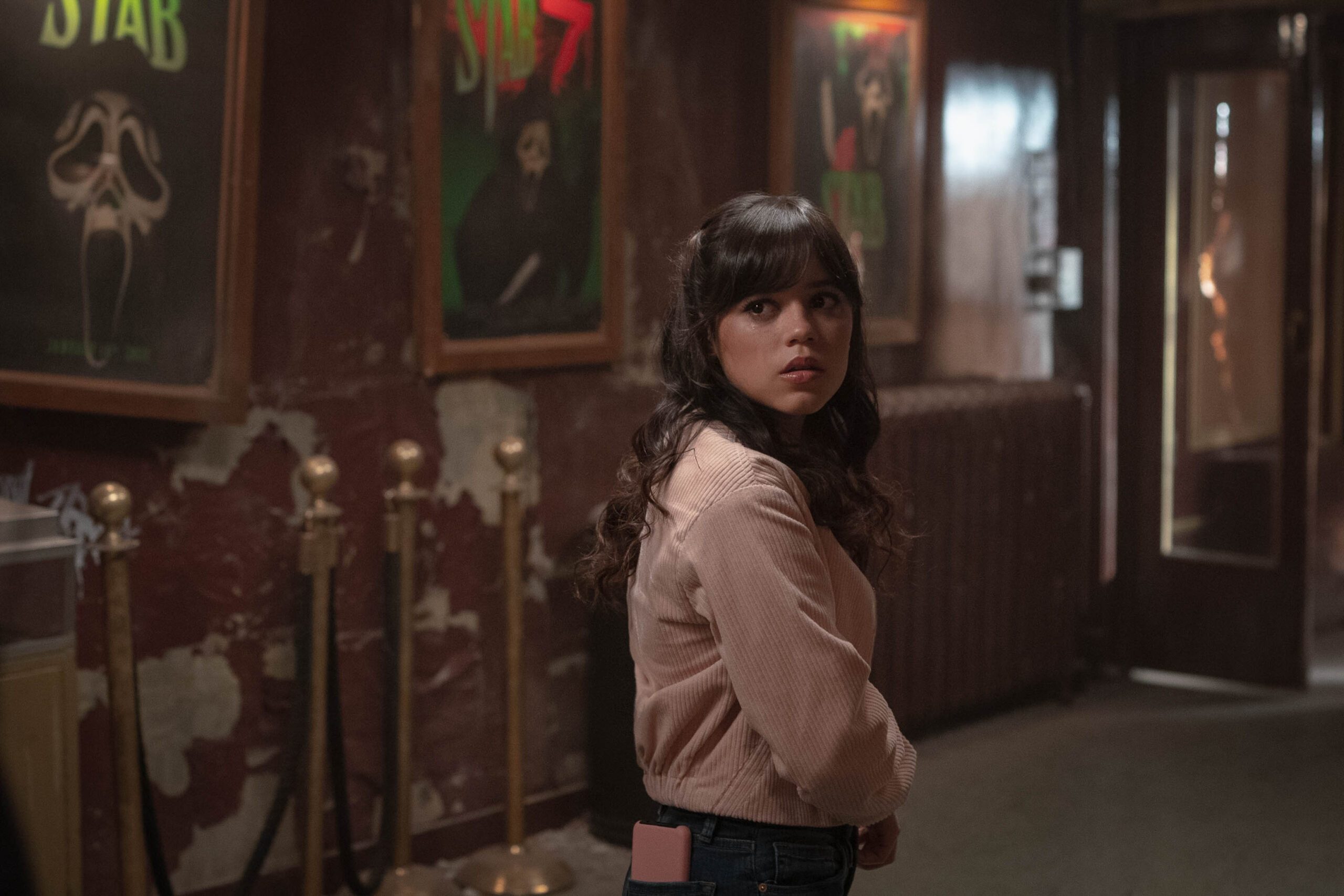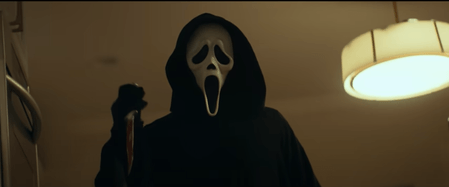SUMMARY
This is AI generated summarization, which may have errors. For context, always refer to the full article.

There are only three things that matter to me in a Scream film: 1) Is it an engaging mystery from start to finish? 2) Is it unrelentingly brutal and intense? And finally, 3) Is it clever in its meta-ness? For mega-fans, myself included, this latest Scream film hits all of these checkpoints. But what’s fascinating is that it actually hits some new notes that you wouldn’t really expect seeing in such a densely-packed, self-referential, slasher smorgasbord. It all starts with Melissa Barrera’s Sam Carpenter and Jenna Ortega’s Tara Carpenter, whose sibling relationship is now a sustainable jumping off point for future sequels.
In the film, the pair is more explicitly opposed to each other from the get-go, rather than just being unnaturally paired together as siblings, as was the case in the previous film. Ortega, fresh off of a career-turning role in Wednesday, is reintroduced as a college undergrad who is yet to fully talk about the events that transpired in Woodsboro, where she almost died. In contrast, Barrera’s character is now deeply suspicious of others, has several locks on her doors, and even has a new habit of hiding romantic relationships from her friends. So, Scream VI functions as a look into how two very different people deal with trauma and the distance that creates between them.
This becomes a core theme throughout the film, how scars, bloodshed, and fear connect Ghostface’s victims. That same trauma is ironically commodified, turned into in-world films, novelizations, and easy newspaper sensationalism. Mindy (Jasmin Savoy Brown), the new Randy stand-in, even points out how they’re now in a franchise after the fifth film’s legacy sequel storyline. Given the waning interest of the general audience in the Marvel Cinematic Universe and the slew of new DC films just recently announced, a wink in the general direction of franchises is the most logical option for meta-satire.
Hayden Panettiere returns as Kirby Reed from the fourth Scream film as an FBI agent, and Courteney Cox’s Gale Weathers shows up as the only vestige from the ‘90s cast (Neve Campbell is glaringly absent, but also, let her rest). However, without Sidney in the film, it actually creates a far more nail-biting experience, because you then realize that the legacy characters are now expendable. In particular, Gale engages in a nerve-wracking scuffle with Ghostface, highlighting her tactical advantage gained from experiencing five films of similar encounters.
In execution, the film isn’t a franchise sequel; it feels more like another legacy sequel. A legacy sequel of Scream 2 specifically, which coincidentally, is my favorite of the franchise. There are quite a lot of similarities between the two, including the bigger budget; a new college campus; a tense scene involving crawling; a protagonist grappling with intense trust issues; and a much more vicious Ghostface. Its freshest update is having it all take place in New York, a place so crowded and claustrophobic that it would naturally seem to offer many opportunities for tension and atmosphere, but the film is perplexingly sparing in that aspect.
There’s one really good scene in the film that I wish wasn’t spoiled in trailers because it would’ve been utterly suspenseful to see unfold the first time. There are wonderful set-ups for each scare, the locations used for the Ghostface encounters doing most of the heavy-lifting. Cramped subway trains, dark alleyways, mundane bodega stores, and ominous cinemas become nightmare fuel for the faint of heart. What always scared me about Ghostface was how well he could blend into environments, let alone a whole crowd dressed up like him (which is why the opening scene of Scream 2 is the best of the franchise, fight me).
Being the sixth film of a long and ostensibly unending franchise, it’s inevitable for it to venerate its own success. The film’s own conceit: the passing down of the torch from the original cast to the next generation is starting to feel like the burgeoning of new clichés that, inasmuch as the Scream franchise wants to poke fun at, is what they desperately need to lean on to keep the engine running. There’s a scene wherein Mindy mentions how everyone is in danger, no matter how important they are in the cast, because they’re in a much bigger and scarier sequel now, but are they?
Mason Gooding’s character Chad, along with his twin sister Mindy and the duo of Sam and Tara, form the new “Core Four” that’s being set up to replace the original trio of Sidney, Gale, and Dewey for the foreseeable future. That trio was able to last 25 years together, and if the Scream franchise really wants to “subvert expectations,” then there needs to be more suspense with regards to who bites the dust and who doesn’t. The charm of last year’s reboot was that everyone was a new character and you weren’t sure who were the mainstays and who weren’t, so all bets were off. Now, after this film, it’s as clear as day, especially when finding out who ends up alive in the end. Fortunately, there is enough chemistry and goodwill that was built among these characters that portends great interactions in the future despite sacrificing tension.
There’s a lot of teasing and set-ups the film makes that can possibly pay off in future installments. Is Sam ever going to turn bad in the future like her father? Maybe. Are we ever going to get a film from the perspective of the Ghostface killer and then generate some suspense from that? We almost had that in this one! Is a franchise mainstay going to actually die? Got you! They’re actually fine. I have no problem with these since they’re all well within the vocabulary of the horror genre, and by extension, the Scream films. But, there’s a fine line between opening up the possibility for future plot-points and using those prospects as a crutch. There were two or three moments that felt like the film was veering towards a new angle, but then immediately disregards it.
The biggest flaw of this film is that it was released just one year after the latest one. Sure, it fits the mold of franchise critique because the general output of big studios usually necessitate churning out films every year, but Scream shines when it gives ample time for horror films to evolve and grow before a new installment is released. By combining the elements of the classic slasher movie into recent horror trends, it enables the franchise to act as a celebration of the genre as a whole. Just imagine if the Scream franchise were to incorporate meta commentary on recent horror films like Barbarian, X, Pearl, and the upcoming Evil Dead Rise. By waiting for these films to potentially make cultural impacts, the Scream franchise could have more material and even act as a judge on the horror landscape after every three or five years.
Either way, Scream VI was undeniably fun. I can genuinely see the Scream franchise going on forever. It’s a franchise that reacts to the zeitgeist and then feeds on whatever trendy generational buzz word will make cinephiles post screenshots on Twitter. As long as the cult of letterbox exists, the Scream franchise will continue to thrive. It’s like a self-sustaining nuclear power plant, and I’ll be eagerly waiting for the next one. – Rappler.com
Scream VI is now showing in Philippine cinemas.
Add a comment
How does this make you feel?

There are no comments yet. Add your comment to start the conversation.